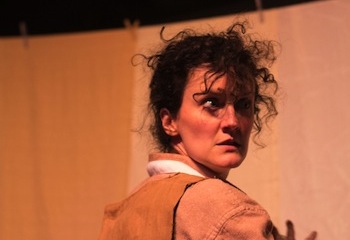Sad Tale of Ireland’s Magdalene Laundries in the 1940s Is Devastating
Magdalen
New York International Fringe Festival
Gene Frankel Theater
24 Bond Street
New York, N.Y.

From 1765 through 1996, the Catholic Church in Ireland ran a chain of large laundries supervised by nuns called the Magdalene laundries. The workers, over 30,000 of them over the centuries, were all prostitutes, rape victims, sexually abused girls, troubled girls and, in later years, the mentally challenged. They were sent to the laundries by their families and the courts in the belief that hard work cleanses the soul and that the good sisters would rehabilitate the women.
They did not. Revelations in the 1990s finally illustrated that the women worked like dogs and lived like prisoners in workhouses attached to the laundries. Many spent years there and some their entire lives. The nuns were overly harsh in their treatment of the girls and many of the girls were physically, sexually and psychologically abused. The centuries of abuse came to light in 1993 when contractors who dug up a convent courtyard discovered 155 skeletons belonging to the girls at the laundries. Following that discovery, many of the girls finally went public and told their sordid stories. A national scandal followed. Several years later, another church sex scandal ensued when it was revealed that many young Irish boys were molested by priests.
The story of the girls, and the nuns, is told in a scorching new play, Magdalen, at the New York International Film Festival, that opened last week. The star of the one-woman play is Erin Layton, who delivers a heartwrenching and thunderous performance that both shocks brings tears. The theme of her electric show is how on earth could the nuns and priests get away with this for over two centuries. Minute after minute, like a slowly lit fuse, the play heats up, hotter and hotter, until it explodes like a criminal and sexual volcano at the end.
Ms. Layton is a theatrical wonder. She plays men and women, nuns, supervisors, and "penitent" girls. She snaps her head left and right to carry on conversations and in one neat trick stages a confessional in which the girl sits upright and talks and then lowers her head to her knees and talks in a deep voice like a priest. Her voice soars from quiet, child-like innocence to the roar of a hardened, veteran nun.
The terror of the play, set in the 1950s, is that these nuns, and priests, always knew exactly what they were doing to the girls. It is the same reason little boys were always afraid to talk about sexual abuse by their parish priests --- nobody would believe them. How can they argue with the leaders of Holy Mother Church? They went on with their damaged lives and tried to forget about those terrible things. That’s what the girls did until the 1993 revelations.
What Ms. Layton does in her play, and her performance, is explain that even if you take away the sexual and psychological abuse, you still have prison-like situations where girls work all day and night with just a few hours off and little to eat. Many had their heads shaved and were stripped naked for inspections. Some of these girls were sent to the laundries by courts, but many were innocently sent their by their families. They were supposed to be rehabilitated, but they lived in conditions harsher than those at most maximum security prisons. Needless to say, they were damaged for life.
Why did civilian workers get involved in the abuse of the girls? In the play, Ms. Layton explains that many of the women workers wanted to become nuns themselves and saw this as a way to do so. Many were simply very religious women who believed the nuns were right, and if they did not believe so, they convinced themselves otherwise over the years.
What about outsiders? The Magdalene laundries earned a considerable amount of money for the Catholic Church with service contracts to large companies, the government and even the army. No one in all those organizations took a look behind the scenes at the laundries? Well, no.
Ms. Layton gets off a sharp zinger at the end of the play, reminding the audience that Pope Benedict XVI publicly apologized to the young boys of Ireland who for years were molested by priests, but never apologized to the Magdalene girls.
He should.
The set, by Cat Tate Starmer, is a wonderful recreation of a large urban laundry. There are huge white sheets (white for purity) hanging on clothes lines and the girls hand wash white sheets, shirts, pants and pillow cases. There is the constant sound of water from the machines running in the background, some quiet, some loud. You really do believe you are in a laundry; it is a surprisingly realistic set for Fringe shows, which are notorious for inexpensive sets.
Ms. Layton’s play does not explore untrod ground, however. Since the mid-1990s there have been several documentary films made on the scandal, along with numerous books and magazine and newspaper articles. Famous performers, including Sinead O’Connor, who spent time as a Magdalene girl herself, have written songs about it. Layton’s play and performance, though, really illuminate the scandal and, nearly twenty years after it started, keeps up the drumbeat for a full investigation of the nuns and the church in Ireland (no one has ever been actually charged with crimes in the scandal).
Hail Mary, full of grace....
PRODUCTION: Sound: Janie Bullard, Costumes: Laura Catignani, Sets/Lighting: Cat Tate Starmer, Sound and Light boards: Basil Horn, Ely Aina Rapoza
